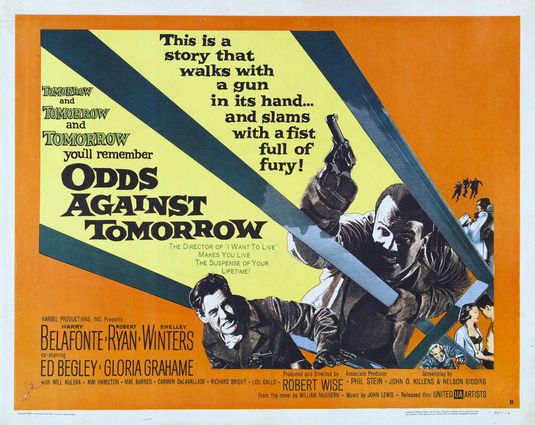Most noted for Harry Belafonte's role as a gambling addict, "Odds Against Tomorrow" is the first film noir to feature an African-American in a primary role. It is also a bleak film of failed lives overwhelmed by tension and fear, followed by rage. Produced by Belafonte's production company, the despairingly titled film works to give a context to racial tensions through the pitiable and harrowing lives contained by this heist flic.
The fascinating set of characters, mean and desperate, draw in the audience with their treacherous attempts at easing their struggles.

Robert Ryan costars as Earl Slater, a white ex-con with a chip on his shoulder and a temper to follow. He chafes at his inability to improve his lot or to avoid violence, ricocheting from bar fight to the door of his pretty, married neighbor, whom he degrades, manipulates and forcefully seduces.
As is often the case with films spearheaded by actors, the character development is primary to the script, and the action begins nearly halfway through the film, as Slater finally commits to a burglary scheme. Then he confronts his new partner, Belafonte, who is also desperate to cash in on the job to pay off his thug creditors from the race track. Slater's racism steams through his eyes and words, and the tension between the two is terrifying. There is no high ground. There is no noble character to raise the situation up to unify the two and bring them together. Instead, these troubled men are thrust together and head off to the heist. "It's gonna let us live again."

Best known for directing musicals like West Side Story as well as The Day The Earth Stood Still, director Robert Wise gives New York a harsh, frigid atmosphere. Bare trees and bitter winds penetrate the scenes, causing the actors to brace themselves against the world. Rather than filling this underworld with inky shadows, low angles peer up at the many shades of gray in this morally unhinged arena. Positioning the camera low to the ground, gives the impression of a towering weight about to fall on the characters at any moment. They appear isolated and imbalanced. Out on the streets, buildings loom up in the darkness; the sky is completely out of sight.

For a film about race and social issues, it holds up surprisingly well to this set of contemporary eyes. The score, although occasionally distracting, serves to layer anxiety and 50's jazz strains and intrigue. The conclusion gives the film the feeling of a morality tale, distracting from the potent tension created by these two actors. If the ending had only retained the seething interactions which engage the audience the most, this would have been a far more satisfying film.

No comments:
Post a Comment
I love opinions. But I must say that honey catches more flies than vinegar, and even though I made it through Salo, I don't want to live my life with tons of vile nastiness. So please be honest and polite.